Big-box country: Ground zero of the warehouse boom
BUSINESS. What happens when a mega-warehouse moves to town? We ask Montgomery locals about life in the shadow of their million-square-foot neighbors. This is the second part in a series.
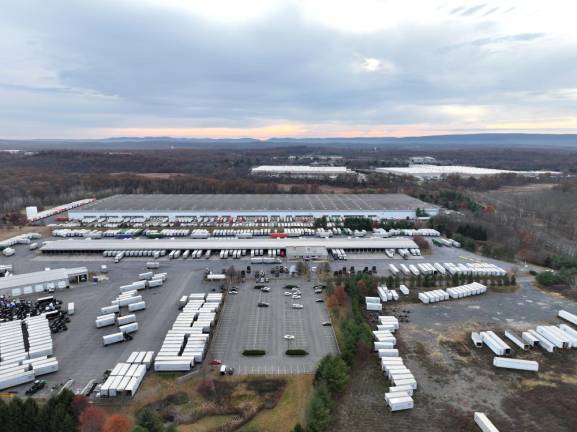
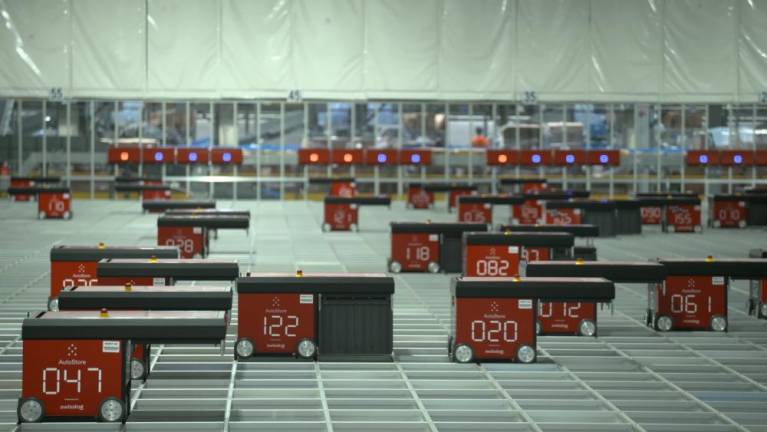
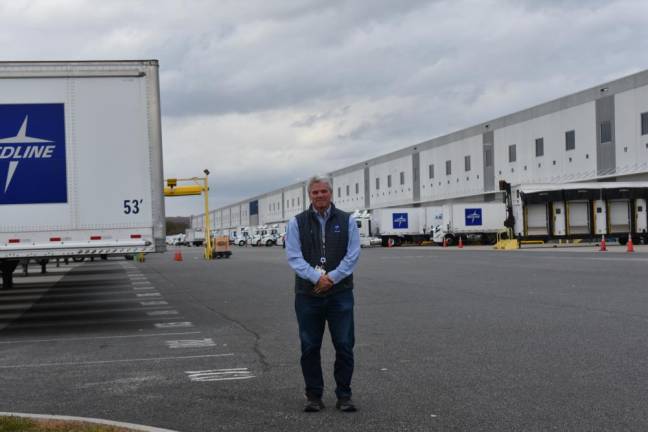
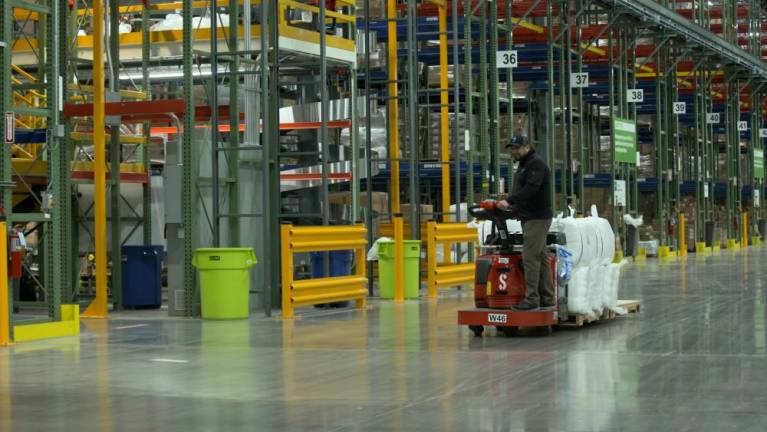

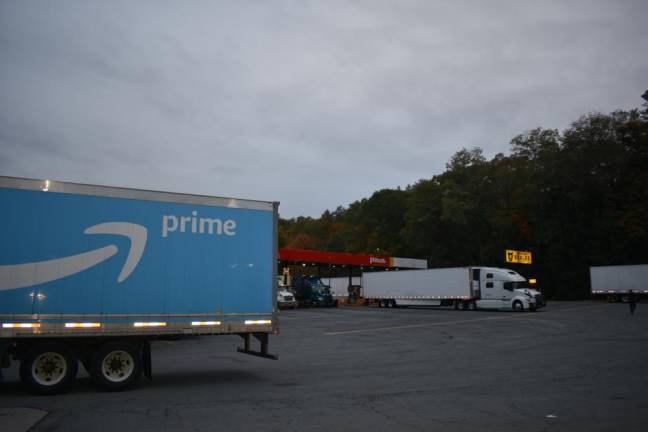
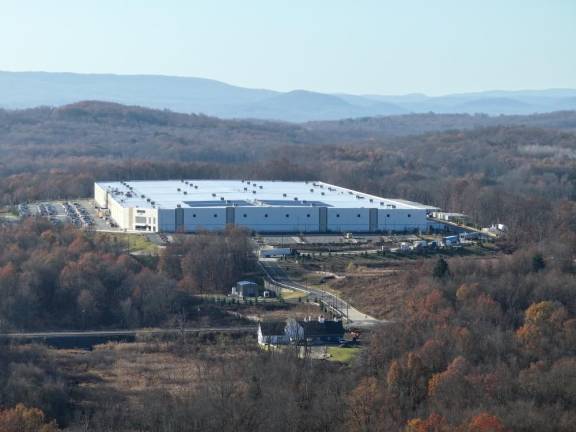
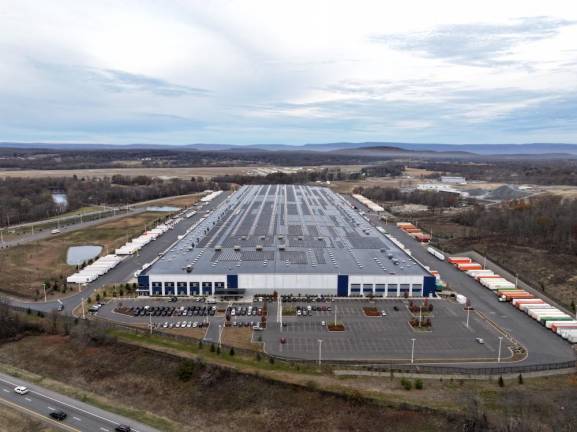
On a Tuesday afternoon in October, the spotless offices of medical supply juggernaut, Medline, are quiet but for the click-clack of a receptionist typing.
Some employees are taking a late lunch in one of the three cafeterias serving the plant, where conversations unfold in Spanish and English.
The action is on the warehouse floor, where forklifts and order pickers hum amidst towering shelves of medical supplies: catheters, ostomy bags, 376 types of exam gloves; vaccines stored in walk-in coolers; the iconic pink-and-blue baby receiving blanket invented by Medline in 1950; and the company’s modern-day bread and butter: sterile surgical procedure trays. The trays are customized not only by procedure (knee replacement, say), but also by the preference, or left-handedness, of a particular surgeon.
Hospitals place their orders by 1 p.m., and by 5 a.m. the next morning, wheeled carts loaded with 20 blue bins apiece are on the hospital’s loading dock, explained Tom Fallon, director of operations of Medline’s Montgomery distribution center.
That turnaround time is made possible by the 236 robots gliding vertically and horizontally along a metal grid – the size of a football field and six stories deep – in the heart of the warehouse. Though slightly outnumbered by the 247 human employees on-site, the robots are doing most of the literal heavy lifting, nimbly yielding for one another while shuffling bins at five times the speed of the fastest human, according to robot manufacturer Swisslog.
Conveyor belts are the warehouse’s circulatory system, carrying incoming product to the robots and outgoing packages to the trucks. The conveyor spurs are equipped with traffic control, so that outbound packages yield to more-urgent packages whose trucks are leaving sooner.
NYU gets 12 trucks a day of Medline product; Mount Sinai, 11 trucks; Montefiore, four trucks; Westchester Medical Center, two trucks daily, said Fallon. This delivery model frees hospitals from having to use valuable space for storing inventory, he explained.
I toured the Medline plant but was not allowed to take photos inside due to proprietary technology, according to the company, which provided photos.
Above us, the largest rooftop solar array in the state is kicking out enough juice to power 1,600 homes. Meanwhile, on the warehouse floor, the 3 p.m. shift is starting. A “team” of about a dozen incoming workers stands in a circle doing some light stretching before heading off onto the warehouse floor to take over where their departing coworkers have just left off, in a never-ending dance with the robots.
The million-square-footers
Medline’s warehouse was among Orange County’s first trio of million-square-foot warehouses, which went up fast in the industry-friendly Town of Montgomery. First came the Amazon fulfillment center in 2021, which was, briefly, the largest building in Orange County. But the Everything Store’s distribution hub for oversized items was quickly outstripped by Medline’s 1.3-million-square-foot warehouse the next year; then surpassed again by Cardinal Health, Medline’s top competitor, which expanded its warehouse to 1,341,000 square feet in 2023.
Notwithstanding community opposition, three years later Montgomery is home to about 20 warehouses – built or approved to be built – of 100,000 square feet or larger, and has just about reached its saturation point, according to Assemblyman Brian Maher, who was Montgomery’s supervisor when the big three went up.
The town’s million-square-foot boom is not over yet. A multi-building industrial park totaling more than a million square feet is in front of the planning board, brought by Real Deal Management Group, a New Jersey-based developer with mega-warehouses in the pipeline across Orange County.
There’s no question the historic town of 23,300 has changed since the million-square-footers went up, whether for better or worse depends whom you ask.
“It really depends on how much you value that aesthetic portion and the traffic portion, as opposed to the economic value,” said Maher. “There is a lot of value in having these warehouses, and I think the negatives come from the individuals who don’t want to lose that hometown country feel when you replace a historic farm with a million-square-foot building.”
The downsides: Traffic, air pollution and fraught wheelies
Sleeping with her windows open is a lot less serene than it used to be since the million-square-foot warehouses opened, said Karina Tipton, an environmental consultant who lives on the edge of the Village of Montgomery.
“I’m often getting people blasting by my house either on their way in [to work], or they’re just slamming on the acceleration as they leave. I’ve had to speak to the village board and the police chief about locating one of those ‘you’re speeding’ signs by my house just because it’s so aggressive sometimes.”
There were 418 vehicle accidents reported in the Town of Montgomery in 2023, the highest count the town had seen in at least five years, according to Montgomery Police Department data obtained via the Freedom of Information Law.
Walking to school, biking on the street, “all of those things that we love feel dangerous,” said Tipton, thanks to increased car and truck traffic. “Kids in the Village of Montgomery do the best wheelies on their bicycles, and I’m worried about them.”
Warehouses are encroaching on the village now, too, where houses are so close to the street that residents can feel their foundations shake when trucks go by. A four-warehouse cluster totaling 280,000 square feet is proposed for a swath of undeveloped woods in the Village of Montgomery, “literally across the street from me in undeveloped woods surrounded by wetlands,” said Tipton.
The sense of danger around heavy-duty truck activity is no mirage. In 2022, David Baker, 52, was fatally struck by a forklift carrying a load of drywall while he was folding a tarp used to cover a flatbed trailer, according to the Office of Health and Safety Administration.
“These tractor trailers are massive,” said Maher. “They’re beating up the state roads. They’re beating up some local roads on local deliveries.”
Tractor trailers spilling out of warehouse parking lots and onto roads is a recurring complaint at town meetings.
The strain on local infrastructure extends beyond roads. When alarms at these warehouses go off, police or fire departments have to respond, said Maher, which takes time and manpower – though he also noted that police departments can make additional revenue by providing security to warehouses.
A 2021 study by The Fire Safety Journal found that warehouses and industrial plants have more false alarms than elementary schools; and fewer than prisons.
But perhaps the biggest threat from these warehouses is invisible.
Truck traffic causes air pollution to spike around large warehouses, according to a recent study by scientists at George Washington University that tracked pollutants from space around 150,000 warehouses nationwide. “That’s an impact that we don’t really talk about,” said Tipton.
When Amazon came to town, for instance, the town determined that the million-square-foot warehouse – with its 225 truck bays and more than 1,000 car parking spaces – would “have a minimal impact on air quality,” states the planning board’s environmental findings. “Due to the efficient operations of all intersections, the additional cars and trucks that will be on the road as a result of the Project will not have any significant adverse air impacts from vehicle emissions.”
“Particulate matter causes heart disease,” said Tipton, emphasizing that the impact is not limited to the lungs. Particulate matter, the deadliest form of air pollution, refers to solid particles less than 2.5 micrometers in size – small enough to enter the bloodstream.
Tipton installed a PurpleAir monitor – which anyone can put up and which generates data used by the Environmental Protection Agency – on her porch at the height of wildfire season last year. Though she doesn’t have historical data, the particulate matter readings are higher than she’d expected, and often higher than neighboring areas, she said.
The good news is that Orange County’s air actually got cleaner between 2002 and 2022, and county-wide, we breathe some of the cleanest air in the nation. But those who live near warehouse clusters, which are increasingly being built in low-income communities, bear the brunt of our collective dependence on just-in-time delivery.
In Orange County, 10 percent of residents have asthma, according to the American Lung Association, higher than the national average, and higher than neighboring Sussex County in New Jersey.
The upsides: Lower taxes, walkathon sponsors and jobs
“If you were to take away the revenue created from warehouses in the town of Montgomery, the amount of tax increase is staggering,” said Maher.
People don’t realize it because warehouses have been on the tax rolls for decades, he said, but if they disappeared overnight, residents would see a “massive” jump in property taxes – which fund things like public schools, police and fire protection, libraries and road maintenance. Taxes are top of mind for many in New York and New Jersey, where property tax rates are among the nation’s highest. Orange County property taxes are 20 percent higher than the New York State average (outside New York City).
The 26 industrial properties in Montgomery make up 15 percent of the town’s tax base, according to town tax data. If the industrial sector suddenly went away, the owner of a $500,000 home in Montgomery whose property tax bill is $8,516, would pay about $1,280 more, though in that hypothetical there would also be less wear and tear on roads and demand on first responders.
One thing that warehouses do not tend to generate is school-aged kids, said Maher. They therefore do not increase demand on the school system, which is by far the single biggest taxpayer expense. Compared to high-density housing, most warehouses use relatively little water and sewer and “have a pretty net-positive return when it comes to impact and taxes.” School taxes account for 72 percent of the property tax bill in Montgomery, he added.
Mega-business also provides a roster of sponsors for Alzheimer’s awareness walks and little leagues. “They can’t always say yes to everything – or they can, they don’t always – but it’s something where they’ve been a pretty good partner,” said Maher.
For Veteran’s Day, Amazon’s Montgomery warehouse gave $5,000 to Mental Health America of Dutchess County, which offers services to local veterans.
Medline’s Montgomery facility, which is on course to do more than $2 billion in sales this year, gave a grant of $25,000 in June through the Community Foundation of Orange and Sullivan to five local organizations to address the “social determinants of health.”
One grant winner, All One One All Farm in Goshen, is putting the $5,000 toward its grow-to-donate program that provides produce and eggs to the food bank. “It’s allowed our farm to level up with it,” said farmer Alix Daguin. “We have so many awesome local farms growing amazing food, and we have people in need in Orange County, especially seniors.”
Elizabeth Rowley, president of the Community Foundation of Orange and Sullivan, which did the legwork for the Medline grant, said, “Corporate giving is really essential, especially in small communities like ours, where it’s a big deal that these large corporations are coming to town.”
Medline is the first mega-business the foundation has worked with. “But we’re here and ready for it,” she said. “We have to maximize the benefits where we can, because it is a reality, and there’s no fighting it.”
For a certain type of local business – delis, gas stations, landscapers – warehouses mean customers.
“Small businesses, eateries and the like, have really made gains when these big establishments are built,” said Maureen Halahan, president and CEO of the Orange County Partnership, whose mission is to build the local economy by attracting and expanding businesses.
“You can’t imagine how much pizza we order,” said Fallon. The day of my visit, Medline had just ordered lunch for 40 employees from Java Blue Coffee, a family-owned coffee roaster and sandwich shop in town.
“They don’t affect me; they actually improve the business,” said Davide Porcu, the Sardinia-born owner of Java Blue.
He knows neighbors have concerns, but he’s “fine with the warehouses. They come here, the people that work for Medline and McKesson,” as he sees on their shirts, “and they get coffee and they get sandwiches.”
He had to hang up the phone to serve a long line of customers at 10:45 on a weekday morning.
The hundreds of jobs that come with each of these big warehouses – no degree required – may be their biggest community selling point.
In the next installment of “Big-box country,” we look at jobs provided by mega-warehouses.